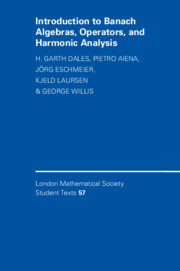Book contents
- Frontmatter
- Contents
- Preface
- Part I Banach algebras
- Part II Harmonic analysis and amenability
- Part III Invariant subspaces
- Part IV Local spectral theory
- 21 Basic notions from operator theory
- 22 Classes of decomposable operators
- 23 Duality theory
- 24 Preservation of spectra and index
- 25 Multipliers on commutative Banach algebras
- Part V Single-valued extension property and Fredholm theory
- Index of symbols
- Subject index
21 - Basic notions from operator theory
Published online by Cambridge University Press: 29 December 2009
- Frontmatter
- Contents
- Preface
- Part I Banach algebras
- Part II Harmonic analysis and amenability
- Part III Invariant subspaces
- Part IV Local spectral theory
- 21 Basic notions from operator theory
- 22 Classes of decomposable operators
- 23 Duality theory
- 24 Preservation of spectra and index
- 25 Multipliers on commutative Banach algebras
- Part V Single-valued extension property and Fredholm theory
- Index of symbols
- Subject index
Summary
Introduction
This part of the book is intended as an invitation to the subject of local spectral theory. It contains the basics and some indications of the way the subject has developed. I would like to thank Garth Dales and Michael Neumann for their numerous good comments and suggestions. The entire story of the fascinating subject that Chapters 21–25 deal with may be found in Laursen and Neumann (2000), and I hope that after having been through these chapters you will want to go for more in that book, which also contains a full bibliography.
The phrase local spectral theory carries many connotations. Among the ones that are appropriate here you should expect to find concepts such as spectral subspaces, that is, invariant subspaces on which the restricted operator has a spectrum consisting of a chunk of the original spectrum. The archetypal conceptual framework is provided by the spectral theorem for normal operators on a Hilbert space, which specifies how this decomposition of the underlying space and of the spectrum is supposed to look. Another similar example is provided by the spectral theorem for compact operators on a Banach space.
Both of these examples may be traced back to what is often a high point of a first course in linear algebra, namely a result on diagonalizing symmetric matrices such as the following. (A symmetric matrix [ai j] satisfies the relations ai j = aji for all i, j, while for a symmetric operator T on a finite-dimensional, real inner-product space V with inner product [·, ·], it is true that we have [T x, y] = [x, T y] for all x, y ∈ V.)
Information
- Type
- Chapter
- Information
- Publisher: Cambridge University PressPrint publication year: 2003
